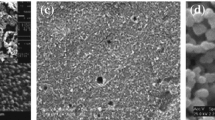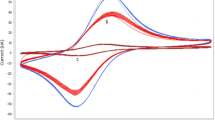Abstract
Self-assembled monolayer (SAM) of cobalt teraaminophthalocyanine (CoTAPc) was developed on thioctic acid (TA) dithiol modified gold electrode and electrochemically evaluated as a glutathione (GSH) selective biosensor. The CoTAPc-TA-Au modified electrode was developed by the covalent immobilization of the CoTAPc as the electrochemical mediator onto previously prepared gold electrode modified with TA (TA-Au) via amid bond formation with the carboxylic group of TA, producing well-organized SAM of the mediator. For comparison, another electrode modified with 3-mercaptopropionic acid (MPA) as a monothiol linker instead of TA was similarly prepared. The electrode surface modification was characterized using SEM, AFM, CV, and EIS. The contact angle measurements of the surface confirmed the formation of CoTAPc SAM on both TA and MPA modified electrodes. The CoTAPc-TA-Au modified electrode showed enhanced catalytic activity for GSH oxidation compared to that of CoTAPc-MPA-Au, indicating that the TA dithiol allowed for more coverage of the catalyst layer on the electrode surface with stronger binding. The experimental parameters controlling the voltammetric processes like scan rate and pH of sample solution were optimized. Using DPV technique, the proposed sensor exhibited a linear response of oxidation peak current vs. GSH concentration, over the concentration range between 10 and 100 μmol L−1 with a LOD of 1.5 μmol L−1 for the CoTAPc-TA-Au modified electrode compared to 5.5 μmol L−1 GSH, for the CoTAPc-MPA-Au electrode. The proposed sensor was utilized for detection of glutathione in some hemolyzed blood samples.

Graphical abstract















Similar content being viewed by others
References
Meister A, Anderson ME (1983) Glutathione. Annu Rev Biochem 52(1):711–760
Giustarini D, Dalle-Donne I, Tsikas D, Rossi R (2009) Oxidative stress and human diseases: origin, link, measurement, mechanisms, and biomarkers. Crit Rev Clin Lab Sci 46(5-6):241–281
Leonel C, Gelaleti GB, Jardim BV, Moschetta MG, Regiani VR, Oliveira JG, Zuccari DAPC (2014) Expression of glutathione, glutathione peroxidase and glutathione S-transferase pi in canine mammary tumors. BMC Vet Res 10(1):49–58
Pastore A, Federici G, Bertini E, Piemonte F (2003) Analysis of glutathione: implication in redox and detoxification. Clin Chim Acta 333(1):19–39
Townsend DM, Tew KD, Tapiero H (2003) The importance of glutathione in human disease. Biomed Pharmacother 57(3-4):145–155
Rossi R, Dalle-Donne I, Milzani A, Giustarin D (2006) Oxidized forms of glutathione in peripheral blood as biomarkers of oxidative stress. Clin Chem 52(7):1406–1414
Castejon AM, Spaw JA (2014) Autism and oxidative stress interventions: impact on autistic behavior. Austin J Pharmacol Ther 2:6–11
Patel RS, Ghasemzadeh N, Eapen DJ, Sher S, Arshad S, Ko Y, Veledar E, Samady H, Zafari AM, Sperling L, Vaccarino V, Jones DP, Quyyum AA (2016) Novel biomarker of oxidative stress is associated with risk of death in patients with coronary artery disease. Circulation 133(4):361–369
Toyo’oka T (2009) Recent advances in separation and detection methods for thiol compounds in biological samples. J Chromatogr B 877(28):3318–3330
Harfield JC, Batchelor-McAuley C, Compton RG (2012) Electrochemical determination of glutathione: a review. Analyst 137(10):2285–2296
Bai S, Chen Q, Lu C, Lin JM (2013) Automated high performance liquid chromatography with on-line reduction of disulfides and chemiluminescence detection for determination of thiols and disulfides in biological fluids. Anal Chim Acta 768:96–101
Schlereth DD, Katz E, Schmidt HL (1994) Toluidine blue covalently immobilized onto gold electrode surfaces: an electrocatalytic system for nadh oxidation. Electroanalysis 6(9):725–734
Willner I, Riklin A (1994) Electrical communication between electrodes and NAD(P)+-dependent enzymes using pyrroloquinolinequinone-enzyme electrodes in a self-assembled monolayer configuration: design of a new class of amperometric biosensors. Anal Chem 66(9):1535–1539
Collinson M, Bowden EF, Tarlov MJ (1992) Voltammetry of covalently immobilized cytochrome c on self-assembled monolayer electrodes. Langmuir 8(5):1247–1250
Duan C, Meyerhoff ME (1994) Separation-free sandwich enzyme immunoassays using microporous gold electrodes and self-assembled monolayer/immobilized capture antibodies. Anal Chem 66(9):1369–1377
Widrig CA, Chung C, Porter M (1991) The electrochemical desorption of n-alkanethiol monolayers from polycrystalline Au and Ag electrodes. J Electroanal Chem 310(1-2):335–359
Gatto E, Stella L, Formaggio F, Toniolo C, Lorenzelli L, Venanzi M (2008) Electroconductive and photocurrent generation properties of self-assembled monolayers formed by functionalized, conformationally-constrained peptides on gold electrodes. J Peptide Sci 14(2):184–191
Koufaki M, Detsi A, Kiziridi C (2009) Multifunctional lipoic acid conjugates. Curr Med Chem 16(35):4728–4742
Saeed AA, Singh B, Abbas MN, Issa YM, Dempsey E (2015) Electrocatalytic nitrite determination using iron phthalocyanine modified gold nanoparticles. Electroanal 27(5):1086–1096
Abbas MN, Saeed AA, Singh B, Radowan AA, Dempsey E (2015) A cysteine sensor based on a gold nanoparticle–iron phthalocyanine modified graphite paste electrode. Anal Methods 7(6):2529–2536
Mashazi PN, Ozoemena KI, Nyokong T (2006) Tetracarboxylic acid cobalt phthalocyanine SAM on gold: potential applications as amperometric sensor for H2O2 and fabrication of glucose biosensor. Electrochim Acta 52(1):177–186
Pereira-Rodrigues N, Cofré R, Zagal JH, Bedioui F (2007) Electrocatalytic activity of cobalt phthalocyanine CoPc adsorbed on a graphite electrode for the oxidation of reduced l-glutathione (GSH) and the reduction of its disulfide (GSSG) at physiological pH. Bioelectrochem 70(1):147–154
Xu H, Xiao J, Liu B, Griveau S, Bedioui F (2015) Enhanced electrochemical sensing of thiols based on cobalt phthalocyanine immobilized on nitrogen-doped graphene. Biosens Bioelectron 66:438–444
Hosseini H, Mahyari M, Bagheri A, Shaabani A (2014) A novel bioelectrochemical sensing platform based on covalently attachment of cobalt phthalocyanine to graphene oxide. Biosens Bioelectron 52:136–142
Wang X, Chen X, Evans DG, Yang WS (2011) A novel biosensor for reduced l-glutathione based on cobalt phthalocyaninetetrasulfonate-intercalated layered double hydroxide modified glassy carbon electrodes. Sensors Actuators B Chem 160(1):1444–1449
Honeychurch KC, Hart JP (2012) The chronoamperometric and voltammetric behaviour of glutathione at screen-printed carbon micro-band electrodes modified with cobalt phthalocyanine. Adv Anal Chem Instrum 2:46–52
Sehlotho N, Griveau S, Ruillé N, Boujtita M, Nyokong T, Bedioui F (2008) Electro-catalyzed oxidation of reduced glutathione and 2-mercaptoethanol by cobalt phthalocyanine-containing screen printed graphite electrodes. Mater Sci Eng C 28(5-6):606–612
NIST X-ray Photoelectron Spectroscopy Database, NIST Standard Reference Database 20, Version. 3.5,by C.D. Wagner, A.V. Naumkin, A. Kraut-Vass, http://srdata.nist.g
Achar BN, Fohlen GM, Parker JA, Keshavayya J (1987) Synthesis and structural studies of metal(II) 4,9,16,23-phthalocyanine tetraamines. Polyhedron 6(6):1463–1467
Willey TM, Vance AL, Bostedt C, van Buuren T, Meulenberg RW, Terminello LJ, Fadley CS (2004) Surface structure and chemical switching of thioctic acid adsorbed on au(111) as observed using near-edge X-ray absorption fine structure. Langmuir 20(12):4939–4944
Matemadombo F, Westbroek P, Nyokong T, Ozoemena K, De Clerck K, Kiekens P (2007) Immobilization of tetra-amine substituted metallophthalocyanines at gold surfaces modified with mercaptopropionic acid or DTSP-SAMs. Electrochim Acta 52(5):2024–2031
Montalbetti CAGN, Falque V (2005) Amide bond formation and peptide coupling. Tetrahedron 61(46):10827–10852
Moulder JF, Stickle WF, Sobol PE, Bomben KD (1992) Handbook of X-ray photoelectron spectroscopy. Perkin-Elmer Corporation, Physical Electronics Division, Eden Prairie
Briggs D, Seah MP (1990) Practical surface analysis, 2nd edn. Wiley & Sons, Chichester
Fang Z, Liu L, Xu L, Yin X, Zhong X (2008) Synthesis of highly stable dihydrolipoic acid capped water-soluble CdTe nanocrystals. Nanotech 19(23):235603
Campuzano S, Pedrero M, Montemayor C, Fatás E, Pingarrón JM (2006) Characterization of alkanethiol-self-assembled monolayers-modified gold electrodes by electrochemical impedance spectroscopy. J Electroanal Chem 586(1):112–121
Braik M, Dridi C, Ali A, Abbas MN, Ben Ali M, Errachid A (2015) Development of a perchlorate sensor based on Co-phthalocyanine derivative by impedance spectroscopy measurements. Org Electron 16:77–86
Schafer FQ, Buettner GR (2001) Redox environment of the cell as viewed through the redox of the glutathione disulfide/glutathione couple. Free Radic Biol Med 30(11):1191–1212
Tian F, Gourine AV, Huckstepp RTR, Dale N (2009) Anal Chim Acta 645(1-2):86–91
Laviron E (1979) J Electroanal Chem 100(1-2):263–270
Prodromidis MI, Florou AB, Tzouwara-Karayanni SM, Karayannis MI (2000) The importance of surface covering in the electrochemical study of electrochemically modified electrodes. Electroanal 12(18):1498–1500
Gulppi MA, Páez MA, Costamagna JA, Cárdenas-Jirón G, Bedioui F, Zagal JH (2005) Inverted correlations between rate constants and redox potential of the catalyst for the electrooxidation of 2-aminoethanethiol mediated by surface confined substituted cobalt-phthalocyanines. J Electroanal Chem 580(1):50–56
Raoof JB, Ojani R, Baghayeri M (2009) Simultaneous electrochemical determination of glutathione and tryptophan on a nano-TiO2/ferrocene carboxylic acid modified carbon paste electrode. Sensors Actuators B 143(1):261–269
Lenton KJ, Therriault H, Cantin AM, Fülöp T, Payette H, Wagner JR (2000) Direct correlation of glutathione and ascorbate and their dependence on age and season in human lymphocytes. Am J Clin Nutr 71(5):1194–1200
Chung JS, Haque R, Mazumder DNG, Moore LE, Ghosh N, Samanta S, Mitra S, Hira-Smith MM, von Ehrenstein O, Basu A, Liaw J, Smith AH (2006) Blood concentrations of methionine, selenium, beta-carotene, and other micronutrients in a case-control study of arsenic-induced skin lesions in West Bengal, India. Environ Res 101(2):230–237
Bridgeman MME, Marsden M, MacNee W, Flenley DC, Ryle AP (1991) Cysteine and glutathione concentrations in plasma and bronchoalveolar lavage fluid after treatment with N-acetylcysteine. Thorax 46(1):39–42
Singh M, Jaiswal N, Tiwari I, Foster CW, Banks CE (2018) A reduced graphene oxide-cyclodextrin-platinum nanocomposite modified screen printed electrode for the detection of cysteine. J Electroanal Chem 829:230–240
Hernández-Ibánez N, Sanjuán I, Montiel MÁ, Foster CW, Banks CE, Iniesta J (2016) L-Cysteine determination in embryo cell culture media using Co(II)-phthalocyanine modified disposable screen-printed electrodes. J Electroanal Chem 780:303–310
Ziyatdinova G, Kozlova E, Budnikov H (2018) Selective electrochemical sensor based on the electropolymerized pcoumaric acid for the direct determination of L-cysteine. Electrochim Acta 270:369–377
Kurniawan A, Kurniawan F, Gunawan F, Chou SH, Wang MJ (2019) Disposable electrochemical sensor based on copper-electrodeposited screen-printed gold electrode and its application in sensing L-Cysteine. Electrochim Acta 293:318–327
Premlatha S, Selvarani K, Bapu GNKR (2018) Facile electrodeposition of hierarchical co-Gd2O3 nanocomposites for highly selective and sensitive electrochemical sensing of L–cysteine. ChemistrySelect 3(9):2665–2674
Moore RR, Banks CE, Compton RG (2004) Electrocatalytic detection of thiols using an edge plane pyrolytic graphite electrode. Analyst 129(8):755–758
Tang H, Chen J, Nie L, Yao S, Kuang Y (2006) Electrochemical oxidation of glutathione at well aligned carbon nanotube array electrode. Electrochim Acta 51(15):3046–3051
Rover LR Jr, Kubota LT, Hoehr NF (2001) Development of an amperometric biosensor based on glutathione peroxidase immobilized in a carbodiimide matrix for the analysis of reduced glutathione from serum. Clin Chim Acta 308(1-2):55–67
Gong KP, Zhang MN, Yan YM, Su L, Mao LQ, Xiong SX, Chen Y (2004) Sol-gel-derived ceramic-carbon nanotube nanocomposite electrodes: tunable electrode dimension and potential electrochemical applications. Anal Chem 76(21):6500–6505
Abiman P, Wildgoose GG, Compton RG (2007) Electroanalytical exploitation of nitroso phenyl modified carbon-thiol interactions: application to the low voltage determination of thiols. Electroanal 19(4):437–444
Olmos Moya PM, Martínez Alfaro M, Kazemi R, Alpuche-Avilés MA, Griveau S, Bedioui F, Gutiérrez Granados S (2017) Simultaneous electrochemical speciation of oxidized and reduced glutathione. Redox profiling of oxidative stress in biological fluids with a modified carbon electrode. Anal Chem 89(20):10726–10733
Yuan B, Zhang R, Jiao X, Li J, Shi H, Zhang D (2014) Amperometric determination of reduced glutathione with a new Co-based metal-organic coordination polymer modified electrode. Electrochem Commun 40:92–95
Acknowledgements
The authors thank the EU for supporting this work through FP7 Marie Curie IRSES Project: Micro/nano sensors for early cancer warning system–diagnostic and prognostic information “SMARTCANCERSENS.”
Author information
Authors and Affiliations
Corresponding author
Additional information
Publisher’s note
Springer Nature remains neutral with regard to jurisdictional claims in published maps and institutional affiliations.
Electronic supplementary material
ESM 1
(DOCX 82 kb)
Rights and permissions
About this article
Cite this article
Abbas, M.N., Saeed, A.A., Ali, M.B. et al. Biosensor for the oxidative stress biomarker glutathione based on SAM of cobalt phthalocyanine on a thioctic acid modified gold electrode. J Solid State Electrochem 23, 1129–1144 (2019). https://doi.org/10.1007/s10008-018-04191-4
Received:
Revised:
Accepted:
Published:
Issue Date:
DOI: https://doi.org/10.1007/s10008-018-04191-4




